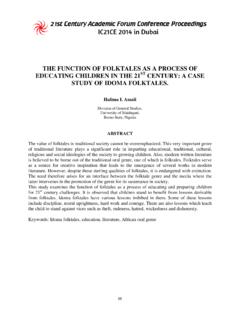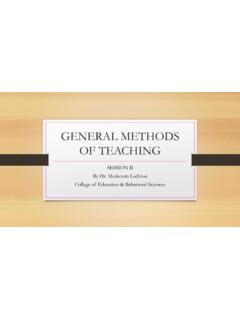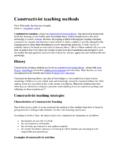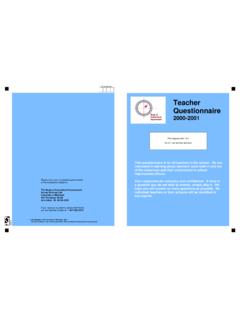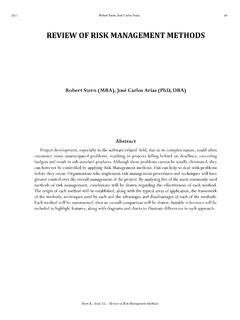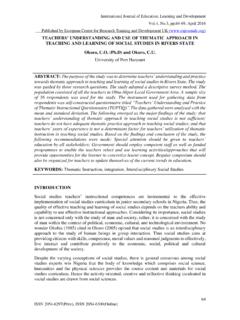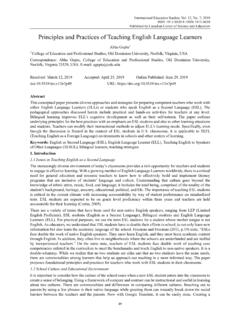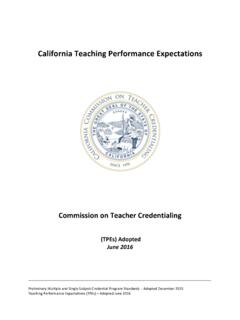Transcription of Comparison of Learning Theories in Mathematics Teaching ...
1 165 Fourth 21st CAF Conference in Harvard, Boston, Massachusetts, USA, March 2016, Vol. 9, No. 1 ISSN: 2330-1236 Comparison of Learning Theories in Mathematics Teaching methods Abdolreza Lessani1, Aida Suraya Md. Yunus1&2, Kamariah Abu Bakar2, Azadeh Zahedi Khameneh2 1 Faculty of Educational Studies, Universiti Putra Malaysia, 43400 Serdang, Selangor, Malaysia 2 Institute for Mathematical Research, Universiti Putra Malaysia, 43400 Serdang, Selangor, Malaysia Abstract The aim of this paper is to compare Learning Theories in Mathematics Teaching , and to study their influence on Mathematics Learning . Numerous studies have shown that students experience Mathematics anxiety, which is a feeling of tension and fear that interferes with math Learning .
2 This may be attributed to the Teaching methods utilized. Therefore, Teaching methods must be re-examined, taking into account the three major Learning Theories : behaviorism, cognitivism, and constructivism. Behaviorism is a teacher-centered instruction, while cognitivism states Learning is based upon how people mentally process stimuli encountered. Mathematics teachers following a constructivist approach favor extending class time to engage in varied activities associated with the discovery and construction of knowledge. Thus, the qualitative case study method was considered more feasible and appropriate to meet the study aim. Data were collected using observation and semi-structured interviews with teachers in secondary schools in Malaysia.
3 It was observed that positive and negative reinforcement (behaviorism), problem solving (cognitivism) and discovery Learning (constructivism) were practiced by the teachers. The findings reveal that students are more successful when systematic problem solving based on Polya s approach is incorporated into discovery Learning . Consequently, there should be more emphasis on Teaching methods which include less lecture, more student-directed classes and more discussion. The findings suggest that problem-solving and discovery- Learning skills not only contribute to better Mathematics Learning but also enhance students creativity to cope with life challenges. Keywords: Learning Theories , Mathematics Teaching methods , behaviorism, Cognitivism, constructivism Abdolreza Lessani, Aida Suraya Md.
4 Yunus, Kamariah Abu Bakar, Azadeh Zahedi Khameneh 166 Introduction Mathematics became the driving force for almost all technological and scientific developments in the nineteenth and twentieth centuries. It has a big influence on our professional and social daily life activities (Maasz & Schloeglmann, 2006). It plays a crucial role on students success and nation building. Mathematics education has always been treated as an important section of general education and specifically science education. It is believed that a theory is essential to any meaningful development effort. Different cultures and societies have different Theories regarding education, specifically with respect to the Teaching and Learning of Mathematics as illustrated in their curriculum.
5 These variations of beliefs and values concerning Mathematics Learning may result in different Mathematics educational systems. The role of teachers is to facilitate students thinking and Learning . Therefore, teachers should attempt to motivate their students to learn. To be aware of Teaching practice activities done by teachers, we should have enough knowledge about Learning Theories and Teaching methods . Different Learning Theories and Teaching methods have been used in educational systems all over the world. Theories of Learning are the main concern of this study, namely behaviorist theory, cognitive Learning theory, and constructivist theory. These Theories and their applications in the Mathematics Teaching methods will be explained more in the next section.
6 The aim of this paper was to compare Learning Theories in Mathematics Teaching , and to study their influence on Mathematics Learning . Literature Review Learning Theories and Teaching methods Learning is one of the significant features of current psychology. Learning Theories and Teaching methods have been used in different educational systems around the world. Teaching methods involve the use of Learning Theories and each theory has different outcomes in Mathematics education. In order to succeed in Teaching Mathematics , teachers need to enhance their understanding of students Learning abilities, experiences, reasoning, and logical abilities. In doing so, they can employ this knowledge as a basis of their Mathematics education strategies.
7 The teachers strongly agreed that Mathematics Teaching and Learning is an ongoing process through which students must develop a solid understanding of appropriate Mathematics concepts and procedures at each academic level. These teachers ought to give students enough confidence to discover Mathematics problems and to think critically to solve them as well as their lifelong problems. The following section discusses three Learning Theories , namely behaviorism, cognitivism, and constructivism. Behaviorism The two main creators of behaviorist approaches to Learning were Skinner (1972) and Watson (1996). Watson stated that human behavior is a result of particular stimuli extracted from particular responses, while Skinner remarked that habits each of us develop stem from our distinctive operant Learning experiences (Shaffer, 2000).
8 One of the most popular descriptions of Learning is the one proposed by Kimble (1961, p. 6) stating Learning as a relatively permanent change in behavioral potentiality occurs as a result of reinforced practice. Kimble s definition has highlighted three aspects of Learning . First, Learning is manifested by a change in behavior. Second, this behavioral change is relatively permanent. Third, the change in behavior does not occur immediately following the Learning experience (Hergenhahn & Olson, 2005). In education, behaviorists apply rewards and punishments system in their classrooms effectively. They believe that rewards have significant roles in Learning . The Teaching methods based on behaviorism emphasize the claim that behavior can be shaped by Comparison of Learning Theories in Mathematics Teaching methods 167 reinforcement through drill and practice.
9 They set clear objectives to help students and teachers (Hergehahn & Olson, 2005). In a Mathematics class, using the behaviorist theory, the teacher reviews previous material and homework, and then demonstrates low-level problem solving followed by seatwork imitating the teacher s demonstration (Stonewater, 2005). This pedagogical approach of placing the primary focus on the teacher as a transmitter of knowledge (that is, Teaching by telling) is representative of a behaviorist theory (Hackman, 2004). The common method of Teaching Mathematics using the behaviorists theory is teacher-centered and giving lecture is the dominant practice. Cognitivism The cognitive approach is another important theory.
10 Piaget (1936) was the first psychologist to make a systematic study of cognitive development. Cognitive development is a progressive reorganization of mental processes as a result of biological maturation and environmental experience. Cognitive Learning theory suggests that Learning is based upon how people mentally process stimuli encountered (Ormord, 1995). In reaction, as early as 1956, Benjamin Bloom created a taxonomy for cognitive skills that included knowledge, comprehension, application, analysis, synthesis, and evaluation, which he believed teachers should help students, so that they use and develop. The six stages are further elaborated and revised in the study by Anderson and Krathwohl (2001) as Remembering, Understanding, Applying, Analyzing, Evaluating, and Creating (Wilson, 2013).

